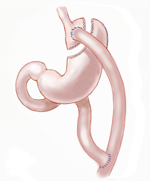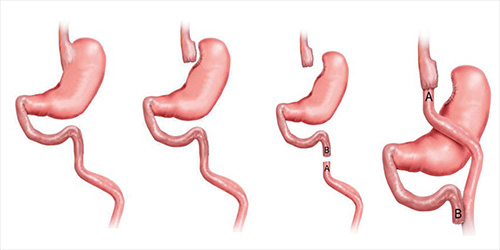General features

IMPACT MECHANISM
- The patient, whose stomach has been reduced in size by performing a RNY Gastric Bypass, consumes smaller portions of food and feels much faster satisfied.
- The RNY Gastric Bypass operation is also a malabsorptive procedure and limits the total calorie intake.
- Postoperatively, the level of ghrelin hormone decreases (appetite hormone).
The fast and voliminous consumption of calorie-rich food (especially food containing carbohydrates and fats) can cause nausea. To prevent this, the patients adapt to eat healthier and changes their eating/drinking habits

1.
The first image shows the oesophagus, the stomach, and the beginning of the small intestine.
2. In the RNY Gastric Bypass operation, the stomach is separated with a staple into a small piece and a large piece, so that the patient can eat smaller portions (restrictive effect).
3.The small intestine is divided (A) and and ready to be connected with the reduced stomach.
4.The small intestine (A) is pulled up from where it is divided and connected to the gastric pouch with a circular stapler.
There is no entry of food in the remnant stomach but this remnant stomach will still produce juices and necessary enzymes needed for digestion and absorption of nutrients. At point B on this figure, the remnant stomac and the continuing small bowel end of this remnant stomach is reconnected to the main route of the nutrients. Thus, the enzymes and juices (B) produced by the remnant stomach enter the main circuit at a more distal point.
RNY GASTRIC BYPASS ANIMATION
Based on scientific research, weight loss in our patients occurs as follows.
| * AT 6 WEEKS: | From the initial weight | -%10 |
|---|---|---|
| * AT 3 MONTHS: | From the initial weight | -%15 |
| * AT 6 MONTHS: | From the initial weight | -%20 |
| * AT 9 MONTHS: | From the initial weight | -%25 |
| * AT 12 MONTHS: | From the initial weight | -%30 - 35 |
These numbers may vary depending on the eating, drinking and exercising habits of the patient.
RISKS AND COMPLICATIONS:
| Short term | Long term |
|---|---|
Leakage |
Anastomotic ulcer |
Bleeding | Gallstones |
Respiratory Infection | Incisional hernia |
Embolism | Intestinal Obstruction |
Intestinal Obstruction |
|
Wound infection |
Advantages of RNY Gastric Bypass |
Disadvantages of RNY Gastric Bypass |
|---|---|
|
|
|
|
|
|
|
|
|
|
|